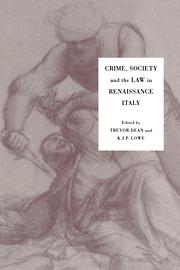Book contents
- Frontmatter
- Contents
- Illustrations
- List of contributors
- Preface
- 1 Writing the history of crime in the Italian Renaissance
- 2 Criminal justice in mid-fifteenth-century Bologna
- 3 The judicial system in Florence in the fourteenth and fifteenth centuries
- 4 The incidence of crime in Sicily in the mid fifteenth century: the evidence from composition records
- 5 Theology, nature and the law: sexual sin and sexual crime in Italy from the fourteenth to the seventeenth century
- 6 Practical problems in the enforcement of Italian sumptuary law, 1200–1500
- 7 The prince, the judges and the law: Cosimo I and sexual violence, 1558
- 8 Intervention by church and state in marriage disputes in sixteenth- and seventeenth-century Florence
- 9 The writer and the man. Real crimes and mitigating circumstances: il caso Cellini
- 10 The political crime of conspiracy in fifteenth- and sixteenth-century Rome
- 11 Fighting or flyting? Verbal duelling in mid-sixteenth-century Italy
- 12 Banditry and lawlessness on the Venetian Terraferma in the later Cinquecento
- 13 Mihi vindictam: aristocratic clans and rural communities in a feud in Friuli in the late fifteenth and early sixteenth centuries
- Index
5 - Theology, nature and the law: sexual sin and sexual crime in Italy from the fourteenth to the seventeenth century
Published online by Cambridge University Press: 14 October 2009
- Frontmatter
- Contents
- Illustrations
- List of contributors
- Preface
- 1 Writing the history of crime in the Italian Renaissance
- 2 Criminal justice in mid-fifteenth-century Bologna
- 3 The judicial system in Florence in the fourteenth and fifteenth centuries
- 4 The incidence of crime in Sicily in the mid fifteenth century: the evidence from composition records
- 5 Theology, nature and the law: sexual sin and sexual crime in Italy from the fourteenth to the seventeenth century
- 6 Practical problems in the enforcement of Italian sumptuary law, 1200–1500
- 7 The prince, the judges and the law: Cosimo I and sexual violence, 1558
- 8 Intervention by church and state in marriage disputes in sixteenth- and seventeenth-century Florence
- 9 The writer and the man. Real crimes and mitigating circumstances: il caso Cellini
- 10 The political crime of conspiracy in fifteenth- and sixteenth-century Rome
- 11 Fighting or flyting? Verbal duelling in mid-sixteenth-century Italy
- 12 Banditry and lawlessness on the Venetian Terraferma in the later Cinquecento
- 13 Mihi vindictam: aristocratic clans and rural communities in a feud in Friuli in the late fifteenth and early sixteenth centuries
- Index
Summary
The literature of the Italian Renaissance abounds with references to sex. No fewer than thirty-five different positions of copulation are described in the Dialogo di Giulia e di Maddalena often attributed to Pietro Aretino; prostitution, troilism, lesbianism and anal intercourse are also reported in passing. Necrophilia appears in Matteo Maria Boiardo's Orlando innamorato, first published in 1483, incest and bestiality in Tommaso Stigliani's Mondo nuovo of 1628. Allusions to male homosexuality are common: in Antonio Beccadelli's L'Ermafrodito, written between 1419 and 1425; in Ruzante's L'Anconitana, produced in the early 1520s; and in Girolamo Parabosco's Ermafrodito, published in 1549. The Priapea were first printed at Rome in 1469, and references to sodomy appear also in works by sixteenth-century authors such as Nicolò Franco, Francesco Berni and Luigi Tansillo, as well as Aretino. And, if we are to believe Ludovico Ariosto, writing in the early sixteenth century, male humanists in the Renaissance not only wrote about these practices, but experimented with some of them too: ‘Few humanists are without that vice that did not so much persuade as force God to lay waste Gomorrah and its neighbour! … The vulgar laugh when they hear of someone who possesses a vein of poetry and then they say, “It is a great peril to turn your back if you sleep next to him”’.
- Type
- Chapter
- Information
- Crime, Society and the Law in Renaissance Italy , pp. 74 - 98Publisher: Cambridge University PressPrint publication year: 1994
- 10
- Cited by



